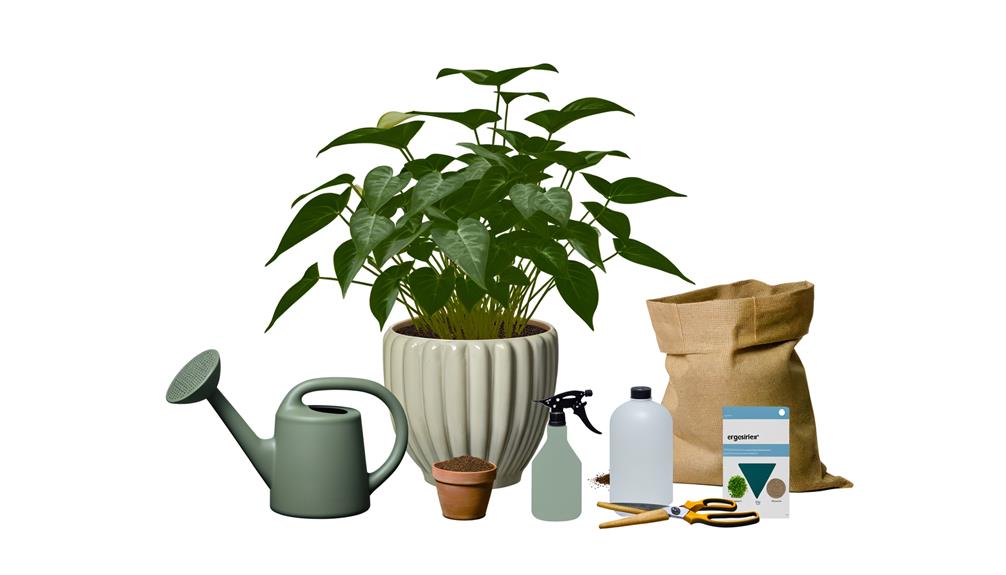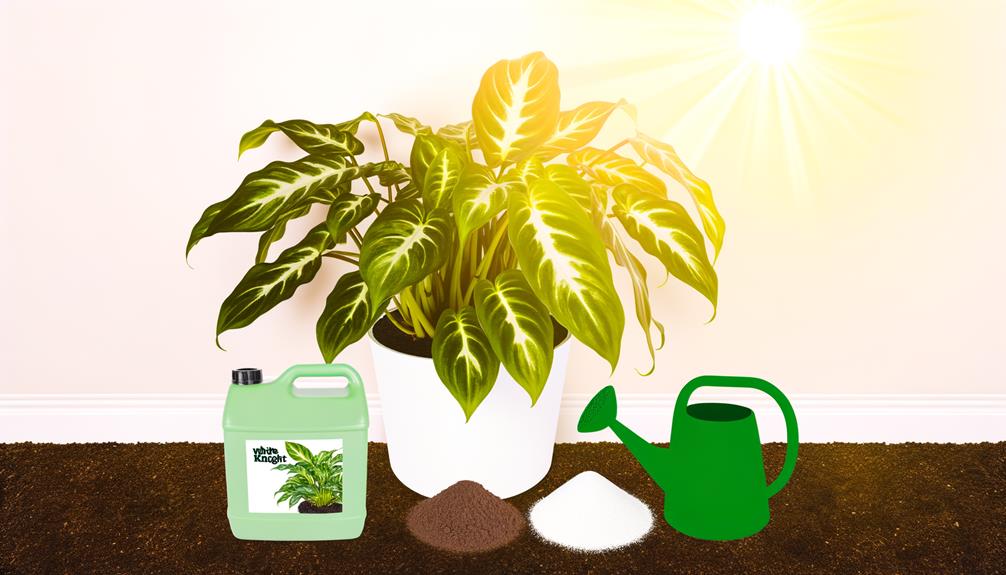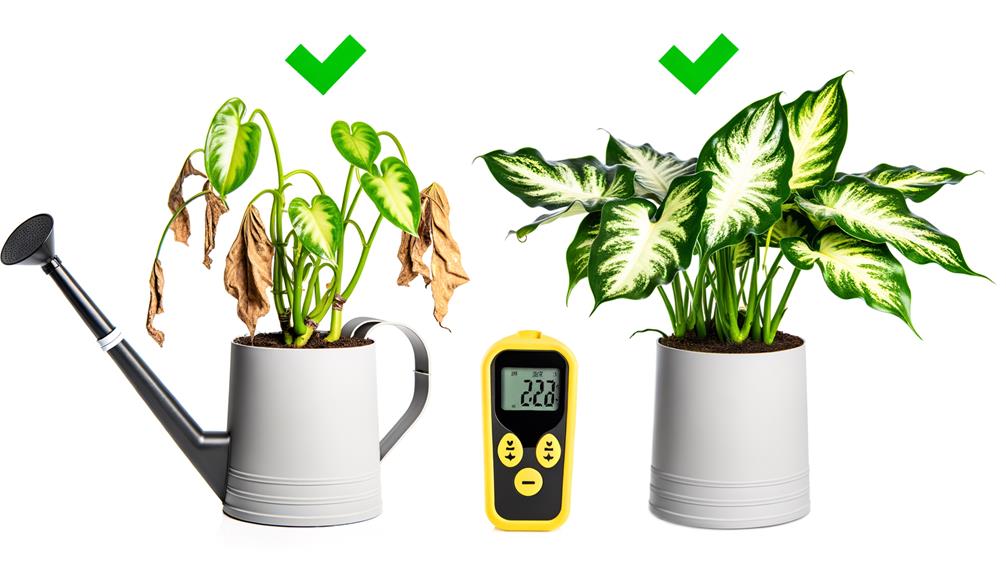White Knight Philodendron Care
White Knight Philodendron, a unique variegated houseplant, thrives under medium to bright indirect light supported by high humidity. It demands well-draining soil composed of organic matter, maintaining pH slightly acidic to neutral.
Watering is fit when the top inch soil feels dry, but avoid waterlogging to prevent root rot. Balanced, water-soluble fertilizers rich in nitrogen, phosphorus, and potassium ensure ideal growth.
Regular pruning and soil testing are vital for its health. Troubleshooting common problems like yellowing leaves and pest infestations is part of the ongoing maintenance.
More nuances in nurturing this exquisite plant are exposed as you explore further.

Key Takeaways
- White Knight Philodendrons thrive in medium to bright indirect light, avoiding direct sunlight to prevent leaf burn.
- Water the plant when the top inch of soil is dry, using filtered or rainwater to avoid chlorine damage.
- Maintain a humidity level between 65-75% for optimal growth, using misting or humidifiers if necessary.
- Pot the plant in well-draining soil with organic matter and slightly acidic to neutral pH, ensuring the container has drainage holes.
- Feed the plant with a balanced, water-soluble fertilizer rich in nitrogen, phosphorus, and potassium, and conduct regular soil tests to avoid over-fertilization.
Understanding the White Knight Philodendron

One must first understand that the White Knight Philodendron, a unique variety of the Philodendron genus, is characterized by its variegated leaves, which exhibit a striking contrast of white and green hues. This stunning aesthetic feature is due to a genetic mutation that results in a lack of chlorophyll in some cells, creating the white patches.
These plants are epiphytic, meaning they naturally grow on other plants and derive nutrients from the surrounding environment, not the host plant. White Knight Philodendrons originate from tropical regions, and consequently, they thrive in high humidity environments.
Understanding these essential biological traits and environmental preferences is vital for anyone who wishes to provide ideal care for a White Knight Philodendron.
Ideal Lighting Conditions
Exploring the delicate balance of light exposure for the White Knight Philodendron requires an understanding of its native habitat's lighting conditions and the impact of light intensity on its growth and variegation patterns.
This specimen thrives in medium to bright indirect light, but direct sunlight can scorch its leaves, causing irreversible damage. Conversely, insufficient lighting may lead to loss of variegation, a key aesthetic feature of this species.
Fluorescent lights can also be utilized, especially in indoor setups lacking natural light. Monitoring light conditions and adjusting accordingly will ensure optimal growth and health.
This cultivar's adaptability makes it an excellent choice for those who desire to serve others by creating inviting, plant-filled environments.
Watering Your Philodendron Correctly

After ensuring your White Knight Philodendron is receiving the proper light, the next important aspect of its care is managing its watering schedule, as this species has specific hydration needs that, when met, contribute greatly to its overall health and well-being.
White Knight Philodendrons require a delicate balance of hydration, not too much, but also not too little. Here are three key water-related aspects to take into account:
- Frequency: Water your Philodendron when the top one inch of soil is dry. Over-watering can lead to root rot.
- Water Quality: Use filtered or rainwater as tap water may contain chlorine that can damage the plant.
- Humidity: This species thrives in 65-75% humidity. Misting or using a humidifier can help maintain ideal levels.
Proper Soil and Potting Techniques
Ensuring the use of appropriate soil and implementing proper potting techniques are critical aspects of White Knight Philodendron care, strongly influencing the plant's overall growth and health. This plant prefers a well-draining soil mix, rich in organic matter, with a slightly acidic to neutral pH.
The following table presents the best soil components and potting guidelines:
| Soil Components | Potting Guidelines |
|---|---|
| Peat moss, perlite, and compost | Use pots with drainage holes |
| Slightly acidic to neutral pH | Repot every 2–3 years |
| Well-draining, rich in organic matter | Clean pots before repotting |
Adherence to these instructions can mitigate the risk of root rot and other diseases, fostering ideal growth conditions. Remember, the potting environment you create significantly impacts the plant's ability to thrive.
Fertilization and Nutrient Requirements

The White Knight Philodendron, like any plant, requires specific nutrients to thrive, which can be supplied through efficient fertilization.
The choice of fertilizer type, and the determination of nutrient needs, are two critical factors in this process.
An accurate understanding of these components will guarantee excellent growth and longevity of the plant.
Appropriate Fertilizer Types
For optimal growth and health of the White Knight Philodendron, incorporating a balanced, water-soluble fertilizer rich in macronutrients such as nitrogen, phosphorus, and potassium is highly recommended. These elements play crucial roles in the plant's metabolic processes and structural formation.
- Nitrogen (N): It is essential for photosynthesis and encourages robust leaf and stem growth.
- Phosphorus (P): This essential nutrient is vital for energy transfer and storage, assisting in root development, flowering, and fruiting.
- Potassium (K): It improves overall plant vitality, enhancing disease resistance, and aids in the regulation of water and nutrient movement in plant cells.
Meeting these nutrient requirements with the appropriate fertilizer type will ensure your White Knight Philodendron thrives, standing as a proof of your effective plant care skills.
Determining Nutrient Needs
Identifying the nutrient requirements of your White Knight Philodendron requires an understanding of the plant's growth patterns, environmental conditions, and inherent nutritional needs. This plant typically requires high levels of nitrogen for best leaf growth, and phosphorus for root development. Additionally, it benefits from micronutrients like magnesium and calcium.
These nutrients can be found in a balanced, slow-release fertilizer, typically with a ratio of 20-20-20. However, the exact nutrient mix can vary depending on the specific soil conditions and the plant's growth stage. Regular soil testing can provide a more precise understanding of nutrient levels and deficiencies.
Over-fertilization can lead to nutrient burn, hence monitoring the plant's response to fertilization is crucial in maintaining its overall health.
Pruning and Maintenance Tips
Employing appropriate pruning techniques and regular maintenance practices is essential for sustaining the health and aesthetic appeal of the White Knight Philodendron.
These procedures, when conducted systematically, can effectively mitigate disease propagation, promote vigorous growth, and maintain the plant's unique variegation.
The following discussion will focus on the detailed methodologies for effective pruning and maintenance, along with the scientific principles underlying these practices.
Proper Pruning Techniques
Effective trimming of a White Knight Philodendron not only enhances its ornamental appeal but also bolsters its overall health, demanding a detailed understanding of the correct techniques and best timing for this task.
The appropriate methodology for trimming can be distilled into three vital steps:
- Identify Dead or Diseased Foliage: Inspect the plant meticulously for yellow, wilted, or brown leaves. These are the first indicators of stress and should be removed promptly to prevent further plant deterioration.
- Use Sterilized Cutting Tools: To minimize the risk of transmitting diseases, ensure your trimming shears are clean and sharp.
- Trim at the Right Time: The best time to trim is during the growing season, as the plant can heal swiftly and continue its growth cycle unimpeded.
Right practices will maintain the plant's vitality and create a robust growing environment.
Regular Maintenance Practices
To maintain the longevity and vibrancy of your White Knight Philodendron, consistent upkeep routines, including strategic pruning and careful maintenance, play a crucial role.
Pruning should be done using sanitized tools to prevent disease spread, focusing mainly on dead or yellow leaves to encourage healthy growth. Regularly check the plant for pests like aphids or spider mites, treating with a suitable insecticide if needed.
Soil nutrient levels should be monitored to support excellent plant health, with regular application of a balanced fertilizer to replenish necessary nutrients. Moreover, monitor the plant's environment closely, adjusting light, temperature, and humidity levels as needed.
Regular maintenance practices, when executed correctly, can notably enhance the health and appearance of your White Knight Philodendron.
Troubleshooting Common Problems

A discerning eye can identify and rectify common problems in White Knight Philodendron care, such as yellowing leaves, root rot, or pest infestations, by understanding their underlying causes and adopting appropriate remedies.
- Yellowing leaves may indicate overwatering or poor nutrition. Rectify by adjusting watering routine and making sure the plant has adequate fertilization.
- Root rot often signifies waterlogged soil or inadequate drainage. Amending the soil to improve its drainage properties can help address and reverse this issue.
- Pest infestations can be controlled by regular inspections and prompt action. Use organic or chemical pesticides, depending on the severity of the infestation.
These issues, if neglected, can be detrimental to the plant's health. Therefore, a vigilant approach towards their management can promote thriving growth for your White Knight Philodendron.
Conclusion
To sum up, the cultivation of the White Knight Philodendron requires a thorough understanding of its specific requirements. By providing the right amount of light, water, and nutrients, in addition to suitable soil, potting, and pruning methods, this extraordinary plant can flourish.
Nonetheless, it is crucial to promptly recognize and resolve any possible issues to maintain the plant's health and vigour. A well-kept White Knight Philodendron is a magnificent addition to any indoor or outdoor garden.






